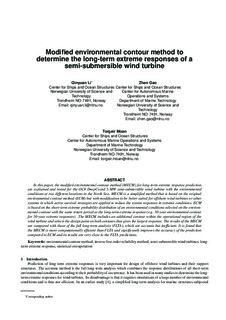| dc.contributor.author | Li, Qinyuan | |
| dc.contributor.author | Gao, Zhen | |
| dc.contributor.author | Moan, Torgeir | |
| dc.date.accessioned | 2017-10-30T09:30:42Z | |
| dc.date.available | 2017-10-30T09:30:42Z | |
| dc.date.created | 2017-09-13T15:18:13Z | |
| dc.date.issued | 2017 | |
| dc.identifier.citation | Ocean Engineering. 2017, 142 563-576. | nb_NO |
| dc.identifier.issn | 0029-8018 | |
| dc.identifier.uri | http://hdl.handle.net/11250/2462767 | |
| dc.description.abstract | In this paper, the modified environmental contour method (MECM) for long-term extreme response prediction are explained and tested for the OC4 DeepCwind 5-MW semi-submersible wind turbine with the environmental conditions at two different locations in the North Sea. MECM is a simplified method that is based on the original environmental contour method (ECM) but with modification to be better suited for offshore wind turbines or other systems in which active survival strategies are applied to reduce the system responses in extreme conditions. ECM is based on the short-term extreme probability distribution of an environmental conditions selected on the environmental contour with the same return period as the long-term extreme response (e.g. 50-year environmental contour for 50-year extreme responses). The MECM includes an additional contour within the operational region of the wind turbine and selects the design point on both contours that gives the largest response. The results of the MECM are compared with those of the full long-term analysis (FLTA), which are accurate but inefficient. It is found that the MECM is more computationally efficient than FLTA and significantly improves the accuracy of the prediction compared to ECM and its results are very close to the FLTA predictions. | nb_NO |
| dc.language.iso | eng | nb_NO |
| dc.publisher | Elsevier | nb_NO |
| dc.rights | Attribution-NonCommercial-NoDerivatives 4.0 Internasjonal | * |
| dc.rights.uri | http://creativecommons.org/licenses/by-nc-nd/4.0/deed.no | * |
| dc.title | Modified environmental contour method to determine the long-term extreme responses of a semi-submersible wind turbine | nb_NO |
| dc.type | Journal article | nb_NO |
| dc.type | Peer reviewed | nb_NO |
| dc.description.version | acceptedVersion | nb_NO |
| dc.source.pagenumber | 563-576 | nb_NO |
| dc.source.volume | 142 | nb_NO |
| dc.source.journal | Ocean Engineering | nb_NO |
| dc.identifier.doi | 10.1016/j.oceaneng.2017.07.038 | |
| dc.identifier.cristin | 1493428 | |
| dc.description.localcode | © 2017. This is the authors’ accepted and refereed manuscript to the article. LOCKED until 20.7.2019 due to copyright restrictions. This manuscript version is made available under the CC-BY-NC-ND 4.0 license http://creativecommons.org/licenses/by-nc-nd/4.0/ | nb_NO |
| cristin.unitcode | 194,64,20,0 | |
| cristin.unitname | Institutt for marin teknikk | |
| cristin.ispublished | true | |
| cristin.fulltext | postprint | |
| cristin.qualitycode | 1 | |

